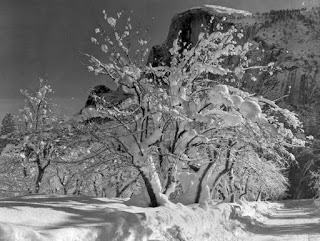This Is the American Earth –
Ansel Adams and Conservation Photography
 |
| http://vault.sierraclub.org/history/ansel-adams/ |
From the thirties to his death in 1984, Ansel Adams was a renown landscape photographer. His work, especially Monolith, remains regarded as one of greatest masterpieces of American art In 1927, Adams clambered though 4,000 feet of deep snow to reach ‘the Diving Board as light failed. Adams had a moment of inspiration. By using a red filter, he turned the sky black against the snow, creating Monolith. However, the stunning shot may not have the simple stroke of luck Schama would have us believe. Heath Johnson (2002), agrees that after publishing Monolith, Adams would become ‘renowned as a dedicated and fastidious technician’. It’s possible he climbed as light failed with a red filter ready in his pocket.
 |
| http://anseladams.com |
Ansel Adams was born in San Francisco in 1902 and began taking photographs as a kid with a Kodak Brownie on family trips to the Yosemite National Park, sustaining a 60 year career as a fine art and commercial photographer, teacher, author and environmentalist. He died at the age of 82 leaving an enormous legacy for conservation photography.
 |
| http://vault.sierraclub.org/history/ansel-adams/ |
I recently watched one the Civilisations a series from the BBC with Simon Schama, who explained the way Adams relied on ‘visualisation’…not what his eye, but the inner lens of his imagination, could see (2018). The idea of seeing the picture before taking it, reminds me of the methods of other visual artists, and indeed creative writers, who talk about imagining their work before commencing it, and indeed on the idea of tracing an image from a camera obscure. Adams spoke about this technique on camera: My basic approach begins with a visualisation of the final photo before exposure is made. When you visualise a photograph, it’s not only matter of seeing it in the mind’s eye, but a matter of feeling it, feeling the various qualities you wish to obtain in the print.
 |
| https://theautry.org/exhibitions/revolutionary-vision-group-f64-and-richard-misrach-photographs-bank-america-collection] |
This passion for wilderness preservation began on a trip to New Mexico in 1941, which yielded one of Adams most famous images, Moonrise Over Hernendez. It’s possible that these two halves – the aesthetic value and the persuasive ability of his work – is the synergy that makes Adams so honoured and enduring as a photographer. Certainly, by the sixties, Adams was generating books, including This Is the American Earth, that were concerned largely with the goal of raising awareness for the campaign to preserve the natural landscape. These influenced its growth as a movement in the US (Encyclopaedia Britannica 2018).
The art work in This Is the American Earth was acclaimed when first presented to the public in exhibition, but the accompanying text by Newhall was too ahead of its time. E.S Deevey (a zoologist from Yale University) reviewing after publication in 1960, having described the plates as ‘a pure aesthetic delight’ writes…The message is grafted on in the form of text by Nancy Newhall…what comes through to me is not Conservation, but Conservationism. By this I mean a tendency to effusive overstatement that make some conservationists sound like member of a cult…Fortunately, any purchaser who can get past the book’s repellent title will probably not even notice the text, and the pictures are magnificent (Deevey 1960).
 |
| Work by Joe Cornish Exhibition Archive http://www.joecornishgallery.co.uk/exhibition-archives-i43 |
This delight in pictures, not the text, makes two points. The first is that Adams never sacrificed artistic value to make an environmental point; What Adams ‘ pictures show us is…not with the description of object—the rocks, trees, and water that are the nominal parts of his pictures—but with the description of the light that they modulate, the light that justifies their relationship to each other…(Robert Turnage, 2016).
Moonlight shines on a majestic Sierra Juniper Peter Essick/National Geographic
The second is the well documented possibility that writing cannot express nearly as well, what a picture can tell us visually. Adam’s work touches nerves within the viewer, influencing photographers like Michael Frye, who works in the Yosomite Nation Park, produce environmental photographic art-work, and acclaimed photographer Peter Essick: I had been inspired by the work of Ansel Adams…he had been a big influence on my work at National Geographic (Keart, 2018).
I was inspired, not as a photographer, but someone who has felt strongly about saving all aspects of the environment for many years. As we get closer to an uncrossable chasm ourselves, remembering that some people took care with what nature offers us is something I like to do.
Read more about Ansel Adams here



